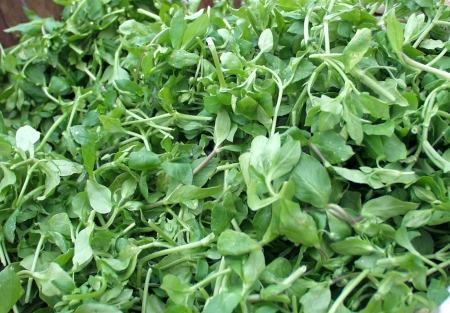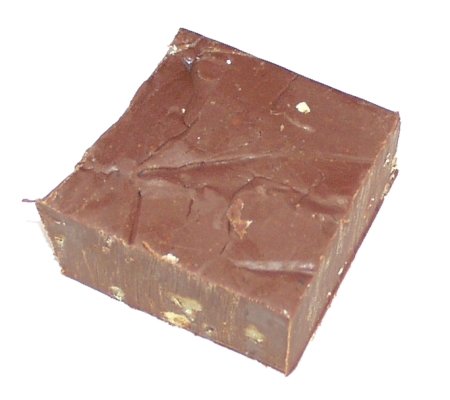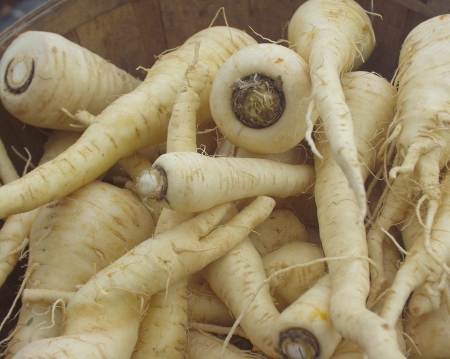
Daffodils from Children's Garden. Photo copyright 2010 by Zachary D. Lyons.
Growing up in Northern New York, we had daffodils this time of year, too. The problem was that they were imported from, well, here, probably, since it was still a frozen tundra there this time of year. Good thing I live here now, eh? While the rest of the country is still battling snow, we are thoroughly diggin’ this whole El Nino thing, aren’t we? To that end, do pickup a beautiful bouquet of fresh daffodils from Children’s Garden to brighten up your home without having to disrupt the explosion of yellow and white that yours are giving your yard.

Fresh, tasty Miner's lettuce from Full Circle Farm. Photo copyright 2010 by Zachary D. Lyons.
Another sure sign of spring that we lacked back East is Miner’s lettuce, a.k.a., claytonia or winter purslane. Native to our region, it gets its name because early miners would rely on it for an excellent source of nutrition after long, hard winters. Find cultivated Miner’s lettuce (above) from Full Circle Farm, or wild-harvested from Foraged & Found Edibles.

Fresh chickweed from Nash's Organic Produce. Photo copyright 2010 by Zachary D. Lyons.
It was a pair of cockatiels that originally taught me to appreciate that chickweed is indeed a tasty treat. But it is Nash’s Organic Produce that I first saw actually bring it to market. Chickweed is a highly nutritious green, like Miner’s lettuce, that is perfect this time of year to give our bodies a kick-start out of the winter blues.

Strawberry starts from Stoney Plains. Photo copyright 2010 by Zachary D. Lyons.
As our ridiculously warm winter quickly heads officially into spring, many farmers are offering plant starts for your garden. Take these strawberry starts from Stoney Plains, for instance. Plant these puppies now, and you’ll be enjoying incredible strawberries right out of your own yard come June.

A trotter & a leg from Sea Breeze Farm. Photo copyright 2010 by Zachary D. Lyons.
Not necessarily a sign of spring, a trotter and a smoked hock is a sign of pork-o-liciousness. Think of all the wonderful dishes you can enhance with these beauties from Sea Breeze Farm. And they are a sure sign that their case will also be full of other fresh, yummy cuts o’ fresh pig. Yay!

Fresh fudge from Pete's Perfect Butter Toffee. Photo copyright 2010 by Zachary D. Lyons.
And there is nothing I can do to tie this gorgeous fudge to spring, other than to say that any time of year is a good time for fudge. You’ll find this fudge at Pete’s Perfect Butter Toffee. You’ll find Pete there, too.

Spicy salad mix from Alm Hill Gardens. Photo copyright 2010 by Zachary D. Lyons.
Back on the spring theme again, how about some tasty, peppy spicy salad mix from Alm Hill Gardens. Lucky for us, the warm winter has meant that salad mixes have returned with a vengeance to your Ballard Farmers Market, which makes our mouths and our bodies very, very happy.

Beef bacon from Olsen Farms. Photo copyright 2010 by Zachary D. Lyons.
Back off the spring theme again, how about some beef bacon from Olsen Farms. You know Olsen for the bazillion kinds of potatoes they grow in the NE corner of our fine state. They have a potato for every application you can think of, and for several you have yet to think of. They also have wonderful beef and lamb, and from that beef they make this beef bacon. We all need more bacon in our lives, so give some of this a try, eh?

Gala apples from Tiny's Organic Produce. Photo copyright 2010 by Zachary D. Lyons.
You will still find plenty of apples at your Ballard Farmers Market, like these gala apples from Tiny’s Organic Produce. Tiny’s also has a great line of jams. and dried fruit, too.
And remember, your Ballard Farmers Market is chock full of all sorts of goodness for your kitchen, from meat, seafood, poultry, cheese, to all sorts of fruits and veggies, baked goods, sauces, confections, fresh-cut flowers and fresh milled flours, plants for the garden, wild mushrooms, and on and on. For a fuller accounting of what you’ll find at the Market today, go to “What’s Fresh Now!” in the upper right-hand corner.


